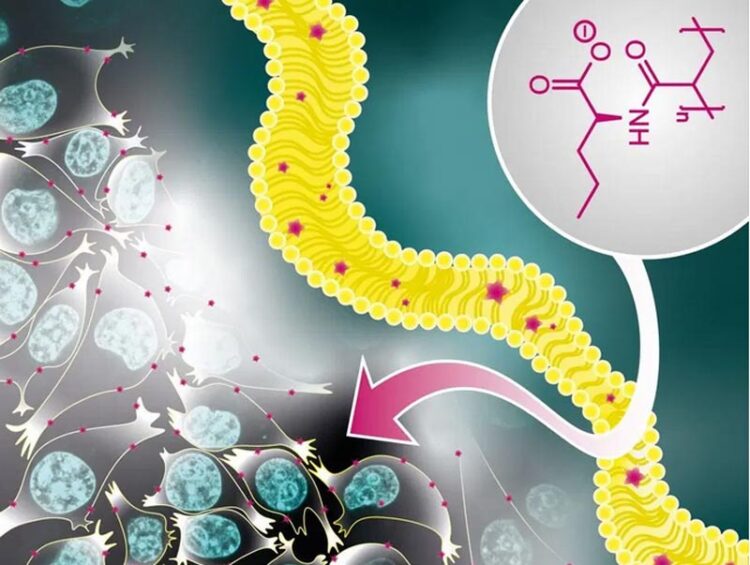New polymers show interaction with cells

Polyanionen: Die neuartigen Polymere können sich langsam an Zellen binden und sich in der Zellmembran anreichern.
(c) Meike Leiske
A new development in biomedical research could open the door to a variety of new applications: Scientists* at the University of Bayreuth have found that certain polymers, called polyanions, can penetrate cells in a unique way without causing damage. The study, which was published in the journal “ACS Polymers Au”, may help to transport active substances into cells in a more targeted manner.
What for?
A team of researchers led by Prof. Dr. Meike Leiske, Junior Professor of Macromolecular Chemistry at the University of Bayreuth, has investigated how polymers can be used to deliver active ingredients of drugs exactly to the place in the body where they are needed. To this end, they have produced a new type of amino acid-functionalized polymer. Amino acids – organic compounds that make up proteins or hormones, for example – were attached to polymers. These novel polymers can bind slowly to cells and accumulate in the cell membrane. This opens up exciting possibilities for the development of new medical applications.
In the current study by Prof. Dr. Meike Leiske, Junior Professor of Macromolecular Chemistry at the University of Bayreuth, polyanions were produced that are derived from amino acids and have different alkyl side chains. These polyanions were produced using a special chemical synthesis method to obtain defined properties. The researchers were able to show that these polymers have a similar ionic charge to the well-known polyacrylic acids, while they are hydrophobic, i.e. water-soluble, in different ways.
The interactions between these polyanions and cells were examined in detail in the study, which was published in the journal ACS Polymers Au. It was found that the polymers bind slowly to the cells and can accumulate in the cell membrane. In particular, the polyanions with a higher hydrophobicity showed stronger binding to the cells.
“Normally, polyanions interact very slowly or not at all with our cells because, like our cell membrane, they also have a negative charge. By using slightly more hydrophobic amino acids, we were able to design the polymers in such a way that they embed themselves in the cell membrane – which does not normally happen – before they are finally taken up,” explains Prof. Dr. Meike Leiske.
This groundbreaking research shows the potential of polymers derived from natural amino acids. The diversity of these materials opens up new ways of adapting their properties for different medical purposes. “The discovery that polyanions can enter cells in a gentle way without damaging them opens up new possibilities for biomedical research. This finding underlines that customized polymers, e.g. based on amino acids, could contribute to the development of innovative approaches for biomedical applications,” says Leiske.
Wissenschaftliche Ansprechpartner:
Prof. Dr. Meike Leiske
Junior Professor Makromolecular Chemistry at the University of Bayreuth
Phone: +49 (0) 921 55 4440
E-Mail: meike.leiske@uni-bayreuth.de
Originalpublikation:
Amino-Acid-Derived Anionic Polyacrylamides with Tailored Hydrophobicity–Physicochemical Properties and Cellular Interactions; Jonas De Breuck, Michael Streiber, Michael Ringleb, Dennis Schröder, Natascha Herzog, Ulrich S. Schubert, Stefan Zechel, Anja Traeger, and Meike N. Leiske; ACS Polymers Au 0, 0, pp; DOI: https://pubs.acs.org/doi/10.1021/acspolymersau.3c00048
Media Contact
All latest news from the category: Life Sciences and Chemistry
Articles and reports from the Life Sciences and chemistry area deal with applied and basic research into modern biology, chemistry and human medicine.
Valuable information can be found on a range of life sciences fields including bacteriology, biochemistry, bionics, bioinformatics, biophysics, biotechnology, genetics, geobotany, human biology, marine biology, microbiology, molecular biology, cellular biology, zoology, bioinorganic chemistry, microchemistry and environmental chemistry.
Newest articles

Sea slugs inspire highly stretchable biomedical sensor
USC Viterbi School of Engineering researcher Hangbo Zhao presents findings on highly stretchable and customizable microneedles for application in fields including neuroscience, tissue engineering, and wearable bioelectronics. The revolution in…

Twisting and binding matter waves with photons in a cavity
Precisely measuring the energy states of individual atoms has been a historical challenge for physicists due to atomic recoil. When an atom interacts with a photon, the atom “recoils” in…

Nanotubes, nanoparticles, and antibodies detect tiny amounts of fentanyl
New sensor is six orders of magnitude more sensitive than the next best thing. A research team at Pitt led by Alexander Star, a chemistry professor in the Kenneth P. Dietrich…





















